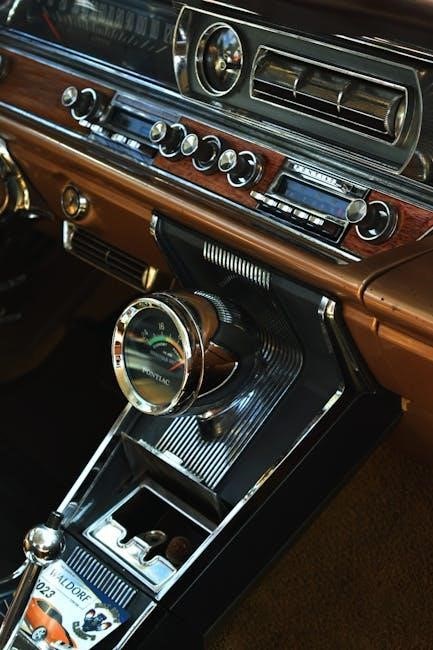The body control module is a critical component in modern vehicles‚ integrating various functions and systems to enhance safety‚ security‚ and convenience‚ using advanced electronics and networking technologies to optimize performance and reliability always.
Definition and Purpose

The body control module is defined as a computerized system that controls and monitors various functions within a vehicle‚ including lighting‚ wipers‚ and security systems. Its primary purpose is to integrate and manage these functions to provide a safe‚ convenient‚ and comfortable driving experience. The module acts as a central gateway‚ processing signals and data from various sensors and systems to control the vehicle’s electrical and electronic components. By doing so‚ it optimizes the vehicle’s performance‚ reliability‚ and efficiency. The body control module is a key component in modern vehicles‚ and its definition and purpose are closely related to its ability to manage and control various vehicle functions. The module’s purpose is to provide a comprehensive and integrated control system that enhances the overall driving experience. This is achieved through the use of advanced electronics and networking technologies that enable the module to communicate with other systems and components within the vehicle.
Importance in Vehicle Design

The body control module plays a crucial role in vehicle design‚ as it enables the integration of various systems and components. This integration allows for a more streamlined and efficient design‚ reducing the complexity of the vehicle’s electrical and electronic systems. The module’s importance in vehicle design is also reflected in its ability to enhance safety‚ security‚ and convenience features. By controlling and monitoring various functions‚ the module helps to prevent accidents‚ protect occupants‚ and provide a comfortable driving experience. Furthermore‚ the body control module enables vehicle manufacturers to offer advanced features and technologies‚ such as keyless entry‚ remote start‚ and driver assistance systems. The module’s importance in vehicle design is evident in its widespread adoption in the automotive industry‚ where it has become a standard component in many modern vehicles. Its impact on vehicle design is significant‚ and it continues to evolve to meet the changing needs of the industry and consumers. The body control module is a key factor in the development of modern vehicles‚ and its importance will only continue to grow in the future.

Functions of Body Control Module
The module manages various vehicle functions‚ including electrical and electronic systems‚ to enhance performance and reliability always using advanced technologies and networking systems.
Vehicle Function Management
The body control module plays a crucial role in managing various vehicle functions‚ including door locks‚ chime control‚ interior and exterior lights‚ security functions‚ wipers‚ turn indicators‚ and power management. This is achieved through the use of signals that coordinate different vehicle functions within a car. The module integrates a fused electrical bus center for power distribution and a body computer in a single module‚ streamlining and optimizing wiring and wiring connections. By removing redundant power feeds and increasing the sharing of fusing‚ the module fully utilizes the capability of the vehicle’s electrical architecture. The vehicle function management capabilities of the body control module enable it to reduce the number of plug-in connections‚ making it a key factor in vehicle design; As automobiles become increasingly complex‚ the body control module is becoming a central component in managing vehicle functions‚ enhancing safety‚ security‚ and convenience. The module’s ability to manage multiple functions makes it an essential part of modern vehicles.
Electronics Architecture
The body control module is tied into the electronics architecture of the vehicle‚ which enables it to reduce the number of plug-in connections and optimize the sharing of signals. This architecture is designed to streamline and optimize the flow of data and power within the vehicle‚ making it more efficient and reliable. The module’s integration into the electronics architecture allows it to communicate with other vehicle systems‚ such as the engine control unit and the transmission control unit‚ to coordinate various vehicle functions. The electronics architecture also enables the body control module to utilize advanced technologies‚ such as networking and signal processing‚ to enhance the vehicle’s overall performance and functionality. By being a part of the vehicle’s electronics architecture‚ the body control module plays a critical role in enabling the vehicle to operate efficiently and effectively. The module’s design and functionality are closely tied to the overall electronics architecture of the vehicle‚ making it a key component in modern automotive systems. The electronics architecture is a complex system that requires careful design and integration to ensure optimal performance.

Body Control Module Design
Vehicle manufacturers design body control modules to meet specific requirements and standards‚ using advanced technologies and materials to ensure reliability and efficiency always in automotive systems and applications effectively.
Integration Concept
The integration concept of the body control module is designed to streamline and optimize wiring and wiring connections by removing redundant power feeds and increasing the sharing of fusing. This concept allows for the integration of multiple functions and systems into a single module‚ making it a central component of the vehicle’s electrical architecture. The body control module integrates a fused electrical bus center for power distribution and a body computer in a single module‚ providing a comprehensive and efficient solution for vehicle manufacturers. By integrating multiple functions into a single module‚ the body control module reduces the complexity of the vehicle’s electrical system and improves reliability. The integration concept also enables the body control module to fully utilize the capability of the vehicle’s electrical architecture‚ providing a flexible and scalable solution for future vehicle designs. This approach has become a key factor in vehicle design‚ as it enables the development of more complex and sophisticated vehicle systems.
Manufacturing Process
The manufacturing process of the body control module involves several stages‚ including design‚ prototyping‚ and testing. The process begins with the design of the module‚ which is typically done using computer-aided design (CAD) software. The design is then used to create a prototype‚ which is tested and validated to ensure that it meets the required specifications. Once the prototype is validated‚ the module is manufactured using a variety of techniques‚ including soldering and wiring. The module is then tested again to ensure that it is functioning correctly. The manufacturing process also involves the use of quality control measures‚ such as inspection and testing‚ to ensure that the module meets the required standards. The body control module is typically manufactured in a controlled environment‚ such as a factory‚ and is subject to strict quality control measures to ensure that it is reliable and functions correctly. The manufacturing process is critical to the production of high-quality body control modules that meet the requirements of the automotive industry. The use of advanced manufacturing techniques and quality control measures helps to ensure that the modules are reliable and function correctly.